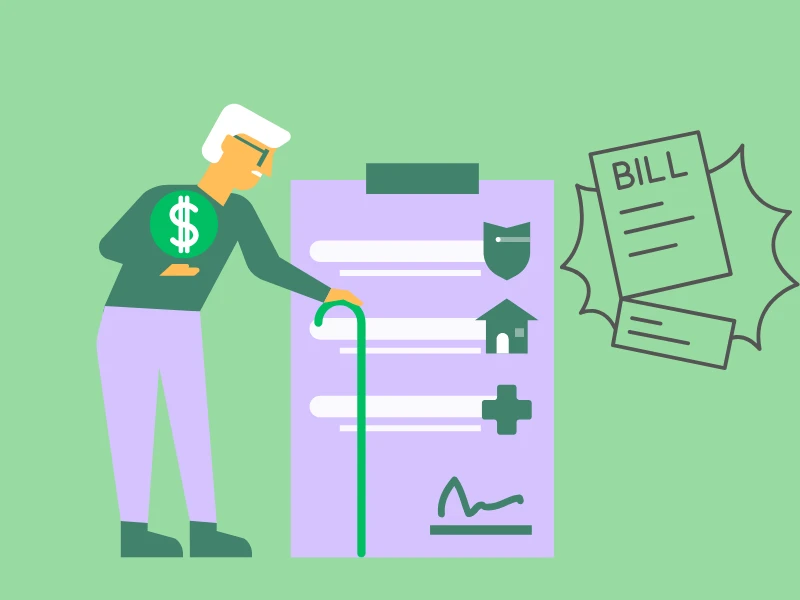Building a Retirement Focused Investment Plan

Introduction
Preparing for retirement is a crucial part of managing your finances, ensuring you have the necessary funds to sustain your preferred lifestyle after you stop working. With a solid plan, many individuals find themselves prepared for the financial challenges that retirement can bring. A well-structured retirement plan helps you navigate uncertainties, such as healthcare costs and inflation, providing security and peace of mind. Starting early enables you to benefit from compound interest, making accumulating the wealth needed for a comfortable retirement easier.
Additionally, planning for retirement is essential because it helps you avoid financial burdens on your family. With a proper plan, you can be more self-sufficient and enjoy your retirement without worrying about financial stability. It also enables you to make informed decisions about when to retire, ensuring you have adequate resources to support yourself throughout your retirement years.
Moreover, having a retirement plan allows you to align your investments with your long-term goals. It gives you a clear understanding of how much you need to save and invest and helps you to stay disciplined in your financial decisions.
The Benefits of a Retirement-Focused Investment Plan
- The benefits of a retirement-focused investment plan are the potential for higher returns through diversified investments.
- It can help reduce risk and enhance the chances of achieving consistent returns.
- Protect your portfolio from market volatility, ensuring you have a steady income stream during retirement.
Furthermore, a retirement-focused investment plan provides a clear roadmap for your financial future. This proactive approach to financial planning ensures you stay on track and reach your retirement objectives. With a well-defined plan, you can confidently make investment decisions, knowing they are aligned with your long-term goals. This clarity and direction empower you to take control of your financial future and build a secure retirement.
Understanding Your Retirement Goals
Defining Your Retirement Vision
Defining your retirement vision is the first step in creating a successful retirement-focused investment plan. Start by envisioning the lifestyle you want to lead when you retire. Consider where you want to live, what activities you want to pursue, and the type of home you wish to have. Do you see yourself travelling frequently, spending time with family, or pursuing hobbies and volunteer work?
Once you have a vision for your retirement lifestyle, it's essential to translate it into specific financial needs. Estimate the cost of maintaining your desired lifestyle, including housing, food, transportation, and entertainment. Consider potential significant expenses, such as home renovations or purchasing a new car. Consider the impact of inflation on these costs over time, as prices for goods and services will likely increase by the time you retire.
Estimating Retirement Expenses

Estimating your retirement expenses is crucial to building a retirement-focused investment plan.
- Healthcare is one of the most significant expenses you will face in retirement. Even if you are eligible for Medicare, planning for out-of-pocket costs, such as premiums, deductibles, and co-payments, is essential. Consider purchasing supplemental insurance to cover these additional expenses and protect your savings from unexpected medical costs.
- Travel is another significant expense to consider in your retirement budget. If you plan to travel frequently or take extended vacations, you must allocate a portion of your savings to cover these costs. Estimate the cost of flights, accommodations, and other travel-related expenses to ensure you can enjoy your retirement adventures without financial stress. Be realistic about how much you can spend on travel each year and factor this into your overall retirement savings goal.
- Leisure activities and hobbies are also essential when estimating your retirement expenses. Whether you enjoy golfing, gardening, or attending cultural events, you must budget for these activities. Additionally, consider any new hobbies or interests you may want to pursue in retirement.
Determining Your Desired Retirement Age
Determining your desired retirement age is key to building your retirement-focused investment plan. The age at which you choose to retire will significantly impact your savings goals and investment strategy. Retiring earlier means saving more aggressively. Conversely, working longer allows you to save more and may enable you to delay drawing on your retirement accounts, giving your investments more time to grow.
Consider your health, job satisfaction, and personal circumstances when deciding your retirement age. If you enjoy your work and are in good health, you may choose to work longer. On the other hand, if your job is physically demanding or you have health concerns, you may prefer to retire earlier. It is also important to consider the implications of your retirement age on your Social Security benefits. Delaying retirement can increase your monthly benefits, providing you with a higher income during retirement.
Identifying Retirement Income Sources in India
Identifying reliable sources of retirement income is a crucial step in planning a financially secure retirement in India. Employee Provident Fund (EPF), this government-backed scheme, is mandatory for salaried employees working in the organized sector. Both the employee and the employer contribute to the EPF, ensuring a substantial corpus by the time the employee retires.
Another significant source of retirement income in India is the National Pension System (NPS). The NPS is a voluntary, defined-contribution retirement savings scheme that allows individuals to invest regularly during their working years.
Additionally, retirees in India often rely on various investment options to generate post-retirement income. Public Provident Fund, Senior Citizens Savings Scheme, and fixed deposits are popular choices due to their safety and guaranteed returns. PPF and SCSS, in particular, offer tax benefits and competitive interest rates, making them ideal for conservative investors seeking stable income. Furthermore, mutual funds, particularly those focused on income-generating assets like debt and dividend-paying equity funds, can provide higher returns for retirees willing to take on a bit more risk. Diversifying across these income sources ensures a balanced and secure financial future in retirement.
Setting Up a Retirement Savings Strategy
The power of compounding is a fundamental principle in retirement planning that underscores the importance of starting to save early and contributing regularly. This exponential growth can significantly boost your retirement savings.
Starting early is crucial because it gives your investments more time to grow. Even small, regular contributions can accumulate into a substantial nest egg over several decades. The longer your money is invested, the more pronounced the compounding effects will be, allowing you to build a larger retirement fund with less effort.
The Role of Asset Allocation

Asset allocation is a main component of a retirement-focused investment plan, as it helps balance the risk and return of your portfolio. The right asset allocation strategy can provide a steady income stream while protecting your investments from market volatility.
Asset allocation optimizes the balance between risk and return. Stocks, for instance, offer higher potential returns but come with greater risk. Bonds, on the other hand, provide more stability and lower returns. By allocating your investments across these different asset classes, you can achieve a diversified portfolio that reduces overall risk while aiming for reasonable returns.
Managing Investment Risk
Assessing Your Risk Tolerance
Understanding whether you are more conservative or aggressive in your investment approach will guide your asset allocation and investment choices. Conservative investors typically prefer stable, low-risk investments such as bonds and fixed deposits, which offer lower but more predictable returns. Conversely, aggressive investors are prepared to accept greater risk in exchange for the potential of achieving greater returns, often investing more heavily in stocks and real estate.
If you are closer to retirement, you might favour a more conservative approach to preserve your capital. Younger investors, who have more time to recover from market downturns, might adopt a more aggressive strategy to maximize growth. Additionally, your disposition towards risk plays a role; if market fluctuations cause significant stress, a more conservative portfolio might be suitable.
Protecting Your Investments
Insurance protects your retirement investments from unforeseen events that could jeopardize your financial security. Various types of insurance, such as health, life or term, and long-term care insurance, can safeguard your assets and provide financial stability in times of crisis. Health insurance is particularly important as medical expenses can quickly deplete retirement savings. Ensuring adequate health coverage can protect your funds and prevent you from having to dip into your investments to cover medical costs.
Life insurance is another essential component, mainly if your dependents rely on your income. A life insurance policy can provide financial support to your loved ones in the event of your unexpected death, ensuring they are not left struggling without your income. Additionally, long-term care insurance can help preserve your retirement savings by covering these expenses, allowing you to use your investments for other retirement needs.
Integrating insurance into your retirement plan creates a financial safety net to protect your assets from unexpected expenses. It lets you focus on growing your investments without worrying about potential financial setbacks. In this way, insurance is crucial in managing investment risk and securing a stable financial future.
Planning for Market Downturns
Market downturns are unavoidable when investing; planning for them is essential to protect your retirement savings. One effective way to safeguard your investments during periods of market volatility is to allocate a portion of your portfolio to safe havens. Safe havens tend to retain or increase in value when markets are in turmoil. Examples include government bonds, gold, and high-quality, dividend-paying stocks. These investments provide stability and mitigate losses when other portfolio parts are underperforming.
Another strategy to manage market downturns is hedging. It involves using financial instruments such as options, futures, or inverse exchange-traded funds (ETFs) to offset potential losses in your portfolio. For instance, purchasing options from your own stock can protect you from significant price declines. Similarly, inverse ETFs increase in value when the market drops, providing a buffer against losses in your other investments. While hedging can be complex and may require professional guidance, it can effectively reduce risk during uncertain times.
Regularly Reviewing and Adjusting Your Plan
The Importance of Periodic Financial Check-Ups
Periodic financial check-ups are essential to ensure your retirement-focused investment plan stays on track. These reviews allow you to evaluate whether your current savings rate, investment strategy, and asset allocation are aligned with your retirement goals. By regularly conducting these check-ups, you can catch any discrepancies early and take corrective action before they become significant problems.
During a financial check-up, you must revisit your retirement goals and ensure they remain realistic and achievable. Your priorities and financial needs may change as you progress through different life stages. Regularly updating your goals helps you stay focused and motivated, providing a clear path to follow. Reviewing your investment performance and comparing it to your expected returns can highlight areas where your portfolio may need adjustments. This process helps balance risk and return, ensuring that your investments work effectively towards your retirement objectives.
Adjusting Your Plan Based on Life Changes
Life is full of unexpected changes, and your retirement plan must be flexible enough to adapt. Significant life events, like health issues, marriage, birth of a child or career changes, can all impact your financial situation and retirement goals. Reviewing and adjusting your retirement plan to reflect your new circumstances is crucial when such events occur. This ensures that your plan remains relevant and practical, helping you stay on track to achieve your retirement objectives.
For example, suppose you receive a significant salary increase. In that case, you may increase your retirement contributions to capitalize on the additional income. Conversely, if you experience a job loss, you might need to temporarily reduce your contributions and reallocate your resources to cover immediate expenses. Life changes, such as buying a home or paying for your children's education, can affect your savings capacity. Regularly adjusting your plan to accommodate these changes ensures that your retirement strategy aligns with your current financial reality.
Staying Informed
The financial markets are constantly changing and influenced by various factors. Staying informed about these changes helps you understand how they might impact your investments and allows you to adjust your strategy accordingly.
One way to stay informed is to regularly read financial news, subscribe to investment newsletters, and follow reputable financial analysts and economists. Understanding these trends helps you anticipate potential risks and opportunities, allowing you to make timely adjustments to your portfolio. For instance, if economic indicators suggest a possible downturn, you might consider reallocating assets to more conservative investments to protect your capital.
Conclusion
Building a retirement-focused investment plan ensures a secure and comfortable future. Understanding your retirement goals, setting up a strategic savings plan, diversifying your investment portfolio, and managing risk lays a strong foundation for financial stability in your later years.
The journey to a successful retirement requires careful planning, disciplined saving, and informed decision-making. Starting early and using compounding growth can significantly boost your retirement fund.
Ultimately, staying engaged with your financial plan and adapting to changes are key to achieving your retirement goals.








